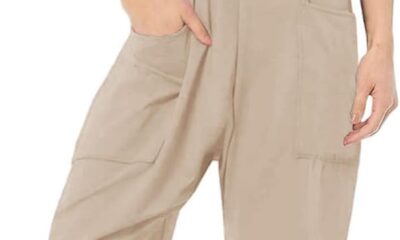Science
Star USC scientist faces scrutiny — retracted papers and a paused drug trial

Late last year, a group of whistleblowers submitted a report to the National Institutes of Health that questioned the integrity of a celebrated USC neuroscientist’s research and the safety of an experimental stroke treatment his company was developing.
NIH has since paused clinical trials for 3K3A-APC, a stroke drug sponsored by ZZ Biotech, a Houston-based company co-founded by Berislav V. Zlokovic, professor and chair of the department of physiology and neuroscience at the Keck School of Medicine of USC.
Three of Zlokovic’s research papers have been retracted by the journal that published them because of problems with their data or images. Journals have issued corrections for seven more papers in which Zlokovic is the only common author, with one receiving a second correction after the new supplied data were found to have problems as well.
For an 11th paper co-authored by Zlokovic the journal Nature Medicine issued an expression of concern, a note journals append to articles when they have reason to believe there may be a problem with the paper but have not conclusively proven so. Since Zlokovic and his co-authors no longer had the original data for one of the questioned figures, the editors wrote, “[r]eaders are therefore alerted to interpret these results with caution.”
“It’s quite unusual to see this volume of retractions, corrections and expressions of concern, especially in high-tier influential papers,” said Dr. Matthew Schrag, an assistant professor of neurology at Vanderbilt who co-authored the whistleblower report independently of his work at the university.
Both Zlokovic and representatives for USC declined to comment, citing an ongoing review initiated in the wake of the allegations, which were first reported in the journal Science.
“USC takes any allegations of research integrity very seriously,” the university said in a statement. “Consistent with federal regulations and USC policies, this review must be kept confidential.”
Zlokovic “remains committed to cooperating with and respecting that process, although it is unfortunately required due to allegations that are based on incorrect information and faulty premises,” his attorney Alfredo X. Jarrin wrote in an email.
Regarding the articles, “corrections and retractions are a normal and necessary part of the scientific post-publication process,” Jarrin wrote.
Authors of the whistleblower report and academic integrity experts challenged that assertion.
“If these are honest errors, then the authors should be able to show the actual original data,” said Elisabeth Bik, a microbiologist and scientific integrity consultant who co-wrote the whistleblower report. “It is totally human to make errors, but there are a lot of errors found in these papers. And some of the findings are suggestive of image manipulation.”
Given the staid pace of academic publishing, publishing this many corrections and retractions only a few months after the initial concerns were raised “is, bizarrely, pretty quick,” said Ivan Oransky, co-founder of Retraction Watch.
The whistleblower report submitted to NIH identified allegedly doctored images and data in 35 research papers in which Zlokovic was the sole common author.
“There had been rumblings about things not being reproducible [in Zlokovic’s research] for quite some time,” Schrag said. “The real motivation to speak publicly is that some of his work reached a stage where it was being used to justify clinical trials. And I think that when you have data that may be unreliable as the foundation for that kind of an experiment, the stakes are just so much higher. You’re talking about patients who are often at the most vulnerable medical moment of their life.”
Over the years, Zlokovic has created several biotech companies aimed at commercializing his scientific work. In 2007, he co-founded ZZ Biotech, which has been working to gain federal approval of 3K3A-APC.
The drug is intended to minimize the bleeding and subsequent brain damage that can occur after an ischemic stroke, in which a blood clot forms in an artery leading to the brain.
In 2022, USC’s Keck School of Medicine received from NIH the first $4 million of a planned $30-million grant to conduct Phase III trials of the experimental stroke treatment on 1,400 people.
In Phase II of the trial, which was published in 2018 and called Rhapsody, six of the 66 patients who received 3K3A-APC died in the first week after their stroke, compared to one person among the 44 patients who got a placebo. Patients who received the drug also tended to report more disability 90 days after their stroke than those who got the placebo. The differences between the two groups were not statistically significant and could have been due to chance, and the death rate for patients in both groups evened out one month after the initial stroke.
“The statements that there is a risk in this trial is false,” said Patrick Lyden, a USC neurologist and stroke expert who was employed by Cedars-Sinai at the time of the trial. Zlokovic worked with Lyden as a co-investigator on the study.
One correction has been issued to the paper describing the Phase II results, fixing an extra line in a data table that shifted some numbers to the wrong columns. “This mistake is mine. It’s not anybody else’s. I didn’t catch it in multiple readings,” Lyden said, adding that he noticed the error and was already working on the correction when the journal contacted him about it.
He disputed that the trial represented any undue risk to patients.
“I believe it’s safe, especially when you consider that the purpose of Rhapsody was to find a dose — the maximum dose — that was tolerated by the patients without risk, and the Rhapsody trial succeeded in doing that. We did not find any dose that was too high to limit proceeding to Phase III. It’s time to proceed with Phase III.”
Schrag stressed that the whistleblowers did not find evidence of manipulated data in the report from the Phase II trial. But given the errors and alleged data manipulation in Zlokovic’s earlier work, he said, it’s appropriate to scrutinize a clinical trial that would administer the product of his research to people in life-threatening situations.
In the Phase II data, “there’s a coherent pattern of [patient] outcomes trending in the wrong direction. There’s a signal in early mortality … there’s a trend toward worse disability numbers” for patients who received the drug instead of a placebo, he said.
None are “conclusive proof of harm,” he said. But “when you’re seeing a red flag or a trend in the clinical trial, I would tend to give that more weight in the setting of serious ethical concerns around the pre-clinical data.”
The NIH paused the clinical trial in November, and it remains on hold, said Dr. Pooja Khatr, principal investigator of the NIH StrokeNet National Coordinating Center. Khatr declined to comment on the pause or the trial’s future, referring further questions to USC and NIH.
The NIH Office of Extramural Research declined to discuss Rhapsody or Zlokovic, citing confidentiality regarding grant deliberations.
ZZ Biotech Chief Executive Kent Pryor, who in 2022 called the drug “a potential game-changer,” said he had no comment or information on the halted trial.
Zlokovic is a leading researcher on the blood-brain barrier, with particular interest in its role in stroke and dementia. He received his medical degree and doctorate in physiology at the University of Belgrade and joined the faculty at USC’s Keck School of Medicine after several fellowships in London. A polyglot and amateur opera singer, Zlokovic left USC and spent 11 years at the University of Rochester before returning in 2011. He was appointed director of USC’s Zilkha Neurogenetic Institute the following year.
A USC spokesperson confirmed that Zlokovic has retained his titles as department chair and director of the Zilkha institute.

Science
This one thing may derail your shot at healthy aging, scientists say

Before you settle in to binge the new season of “The Bear” or watch Team USA go for the gold at the Paris Olympics, think twice about the amount of time you spend on the couch in front of the TV. Your future self may thank you.
A new study by Harvard researchers links the popular pastime of sitting and watching television to the likelihood of reaching one’s senior years in a state of good health: the more time spent doing the former, the lower the odds of achieving the latter.
The problem doesn’t seem to be with sitting in general. After controlling for a variety of risk factors such as diet quality and smoking history, the researchers found no relationship between time spent in a chair at work and the chances of aging well. Ditto for sitting in cars or at home doing something besides watching TV, such as reading, eating meals or paying bills.
Yet for every additional two hours spent in front of the boob tube, a person’s chance of meeting the researchers’ definition of healthy aging declined by 12%, according to their study published this week in JAMA Network Open.
That does not bode well for the United States, where 62% of adults between the ages of 20 and 64 say they watch TV for at least two hours a day, as do 84% of senior citizens.
The findings are based on data from more than 45,000 women who participated in the Nurses Heath Study. All of them were at least 50 years old and had no major chronic diseases back in 1992, when they answered a slew of questions about their health and what they did all day.
For instance, the nurses were asked how much time they spent standing or walking around at work or at home. They were asked about various types of exercise, including jogging, swimming laps, playing tennis and doing yoga. They were asked if they mowed their own lawns.
And they were asked how many hours they spent doing all kinds of sitting.
A couple watches a movie on TV at their home in Norwalk while sharing a bowl of popcorn.
(Francine Orr / Los Angeles Times)
You might not be surprised to learn that the most popular type of sitting was sitting while watching television. More than half of the women — 53% — said they watched between six and 20 hours of TV a week. (The median among this group was around 15.4 hours per week.) Another 15% of the women said they watched between 21 and 40 hours of TV each week, and 2% watched even more.
The nurses were tracked for 20 years or until they died, whichever came first. By the end of the study period, 41% of them were still free of 11 major health conditions, including cancer, diabetes, heart failure, chronic obstructive pulmonary disease and multiple sclerosis. In addition, 44% of the nurses were in good mental health, 52% had no memory impairments and 16% had no physical impairments.
Only 8.6% of the women met all four of those criteria, which was what it took to achieve healthy aging.
On the whole, the women who watched more TV tended to be older, were more likely to be smokers or drinkers, consumed more calories and had higher body mass index scores than women who watched less TV. The more devoted TV watchers were also more likely to have high blood pressure and high cholesterol.
Once the researchers accounted for these and a host of other differences, they found that the women who spent an hour or less each week sitting in front of the TV were the most likely to achieve healthy aging. Compared to them, women who watched TV for two to five hours per week were 9% less likely to be healthy agers; those who watched for six to 20 hours per week were 19% less likely; those who watched for 21 to 40 hours per week were 40% less likely; and those who watched for at least 41 hours a week were 45% less likely.
The researchers also found that replacing TV time with pretty much anything else — including sleep, for women who got no more than seven hours of shut eye per night — would increase their odds of healthy aging. The more vigorous the new activity, the bigger the boost.
Although the actual percentage of women who succeeded in healthy aging was low, the study authors estimated that another 61% of the women could have joined that rarefied group if they had done four things:
- Spent at least three hours per day engaged in light physical activity at work.
- Invested at least 30 minutes a day in moderate to vigorous physical activity.
- Kept their weight in the normal range instead of being overweight or obese.
- Limited their TV-watching time to less than three hours a day.
The study didn’t show that excess TV time caused any of the nurses to miss out on healthy aging, only that there was a significant inverse correlation between the two. Still, there’s good reason to suspect that their favorite sedentary behavior bore at least some of the responsibility.
Previous studies have linked prolonged sitting — especially while watching television — to a variety of health problems, including diseases like breast cancer, colorectal cancer, type 2 diabetes, cardiovascular disease and early death. (That particular study found that compared to sitting for less than three hours a day, sitting for at least twice that long was associated with a 17% increased risk of premature death for men and a 34% increased risk of premature death for women.)
But the researchers from Harvard’s T.H. Chan School of Public Health have taken things a step further, said Dr. I-Min Lee, an epidemiologist at Brigham & Women’s Hospital in Boston who studies how physical activity can prevent chronic diseases and extend life.
“This study expands what we know because it looked at ‘healthy aging,’” said Lee, who was not involved in the study. “‘Health’ is not just the absence of disease; it includes dimensions of physical and mental health, function and well-being.”
All of the study subjects were women, but the biological mechanisms are likely to apply to men as well, Lee said. Even so, it would be good to actually test this relationship in men, as well as in people from a wider range of racial and ethnic backgrounds, she said. (The group of women in the original Nurses Health Study was overwhelmingly white.)
The youngest of the Baby Boomers are now turning 60, and the proportion of the U.S. population that’s at least 65 is projected to increase from roughly 17% today to nearly 21% in 2050, according to the U.S. Census Bureau.
“Population aging is an important public health issue,” the study authors wrote, and strategies to promote healthy aging “are urgently needed.”
Science
Column: The abortion pill is safe. Is your uterus?

Huge sigh of relief.
In a ruling that I happily admit surprised me, the Supreme Court on Thursday affirmed the obvious: Women should have the right to safe medication abortions.
But ladies, our uteri are not safe yet.
For now, in a unanimous decision, the justices have tossed a case that would have prevented the drug mifepristone from being used by women seeking to end pregnancies.
So mify, as the drug is commonly called, is safe. But this is far from the end of the MAGA war on women.
Let’s be clear on this: The ruling wasn’t actually about the drug. It was about the folks who brought the suit, a bunch of doctors who really didn’t have much of a reason to keep millions of women from accessing care other than they didn’t like the care those women wanted.
That’s not actually a reason to sue, even by Samuel Alito and Clarence Thomas standards.
So this ruling is about “standing” and the fact that these docs didn’t have it. Already, antiabortion activists are lining up other cases with defendants whose legal footing is much more solid.
And the Supreme Court is hardly the only front in this war for women’s rights. Here’s three other ways the far-right wants to control female bodies:
First, “fetal personhood” has bubbled up as a scary push by the religious right.
Alito hinted at this concept in the Dobbs ruling, which knocked out Roe vs. Wade, when he referred to an embryo as an “unborn human being.”
In Alabama, we saw this take greater life recently when state Supreme Court judges ruled that embryos created during in vitro fertilization should be considered protected human life (though the state Legislature for now has protected the procedure).
And this week, the Southern Baptist Conference, which speaks for more than 10 million Protestant Americans, announced it would now opposes IVF on those embryos-are-life grounds.
If courts do recognize the idea of fetal personhood, it would pave the way for abortion to be considered not just illegal, but murder. It would also give a state the right to police pregnant women in any way it deems necessary to protect the “unborn child.”
We are already seeing some states attempting to prosecute women for abortions under strict new abortion laws and dozens of states (such as Kansas) either have outright legal language broadly giving fetuses rights or language that edges right up to it. We are closer to this than you think.
The second front on the war on women is contraception.
Though it seems insane and inane to most of us to forbid women from taking the pill or an emergency medication in the immediate aftermath of intercourse to prevent pregnancy, some folks do want to ban it as a form of abortion.
There is a logic to it. If all abortion is illegal, then anything affecting the embryo after conception is off limits.
Finally, there’s former President Trump.
I’ve written before about the Comstock Act, an obscure and angry old law that many speculated the Supreme Court justices might dredge up in this mifepristone case.
That law (which is on the books, but not enforced) theoretically makes it illegal to mail anything that could be used in an abortion — so not just the medication. Hard-liners could argue that anything shipped to an abortion clinic to help it operate could be verboten, even latex gloves.
MAGA types are already floating the frightening notion that if Trump were elected, he could simply bypass courts and Congress and order his Department of Justice to enforce the Comstock Act — ending abortion access without technically ending abortion access.
This week, Trump send a recorded message to the Danbury Institute, an ultraconservative organization that has advocated for abortion to be prosecuted as homicide and called it “child sacrifice.”
He didn’t mention abortion, but there’s this:
“These are gonna be your years, because you’re gonna make a comeback like just about no other group,” he said. “I know what’s happening, I know where you’re coming from and where you’re going, and I’ll be with you side by side.”
So while Thursday’s ruling is a welcome win in the fight to keep women equal, it’s a victorious battle.
The war continues.
Science
You can help name L.A.’s newest dinosaur fossil. Just don't call it Dino McDinoface

Sage? Esme? Gnatalie?
The Los Angeles County Natural History Museum is seeking the public’s help in naming a 70-foot-long sauropod skeleton unearthed by the museum’s paleontologists.
The dinosaur will be the focal point of the NHM Commons, a $75-million welcome center currently under construction on the southwest end of the museum in Exposition Park.
Slated to open this fall, the Commons will offer gardens, an outdoor plaza, a 400-seat theater and a glass-walled welcome center that can be toured without a ticket.
Its centerpiece is the sauropod, whose late Jurassic remains were found in southeast Utah and collected by museum paleontologists between 2007 and 2019. The long-necked, long-tailed dinosaur appears to be part of a new species, similar to the Diplodocus, which will be scientifically named in the future.
Currently under construction at the museum, the skeleton is made up of about 350 fossils from six animals whose bones washed into a river after death some 150 million years ago and commingled.
How to vote
Online poll is open to name Natural History Museum dinosaur fossil
The voting is open until Thursday, June 20. You can choose from five names.
Thanks to celadonite minerals that replaced organic matter during the fossilization process, the fossils are a striking emerald green, unique to this specimen.
Museum staff have long referred to the dinosaur internally as “Gnatalie,” a reference to the relentless gnats that plagued the dig site during the excavation. As its debut approaches, it’s time to turn the dinosaur over to the public.
“We want the people of Los Angeles to feel that this completely unique green giant is theirs, because it is,” said Lori Bettison-Varga, president and director of the Natural History Museums of Los Angeles County. “It’s not every day you build a more than 75-foot-long green dinosaur skeleton.”
In an online poll that runs through June 20, voters can choose from one of five names selected by museum staff:
- Gnatalie: A nod to the original quarry, and the scientists, students and community members who participated in the excavation (and endured the bugs).
- Sage: An iconic green L.A. native plant that is also grown in NHM’s Nature Gardens.
- Verdi: A derivative of the Latin word for green whose variations appear in multiple languages.
- Esme: Short for “Esmeralda,” the Spanish word for “emerald.”
- Olive: Olive trees are green, like the dinosaur, and a symbol of peace in many cultures.
The NHM Commons, depicted in a rendering, is set to open this fall in Exposition Park.
(Frederick Fisher and Partners, Studio-MLA, Studio Joseph / NHMLAC)
By limiting voting to a few pre-approved choices, the museum seeks to avoid the pitfalls of previous naming campaigns that have allowed more latitude for the public’s creativity. Few have forgotten a U.K. government agency’s 2016 online poll to name a $287-million polar research vessel, which yielded a landslide vote for the name “Boaty McBoatFace.”
Despite voters’ overwhelming preference for Boaty over dignified, pre-approved suggestions like “Shackleton” and “Endeavour,” the U.K.’s Natural Environment Research Council ultimately overrode the will of the people and christened its ship the R.R.S. Sir David Attenborough, after the beloved British television host and natural historian. (In a concession to the popular vote, the NERC agreed to grant the McBoatFace moniker to one of the ship’s three autonomous submarines.)
The winning name will be announced on June 25.
-

 Movie Reviews1 week ago
Movie Reviews1 week agoFilm Review: I Used To Be Funny offsets its humorously-adjacent title with a dark, heartbreaking temperament. – The AU Review
-

 News1 week ago
News1 week agoWoman handcuffed in police car hit by freight train reaches $8.5M settlement
-

 World1 week ago
World1 week agoEconomy, migration: Voters' main concerns ahead of elections
-

 Politics1 week ago
Politics1 week agoTrump campaign accelerates vetting of potential running mates
-

 Politics1 week ago
Politics1 week ago'It's absurd': Congress takes bipartisan action after Cuban officials' tour secure parts of major airport
-

 Politics1 week ago
Politics1 week agoHunter Biden trial enters 3rd day with cross-examination of FBI agent
-

 News1 week ago
News1 week agoIsrael used a U.S.-made bomb in a deadly U.N. school strike in Gaza
-

 World1 week ago
World1 week agoFamine ‘likely’ already stalking northern Gaza: Report
















